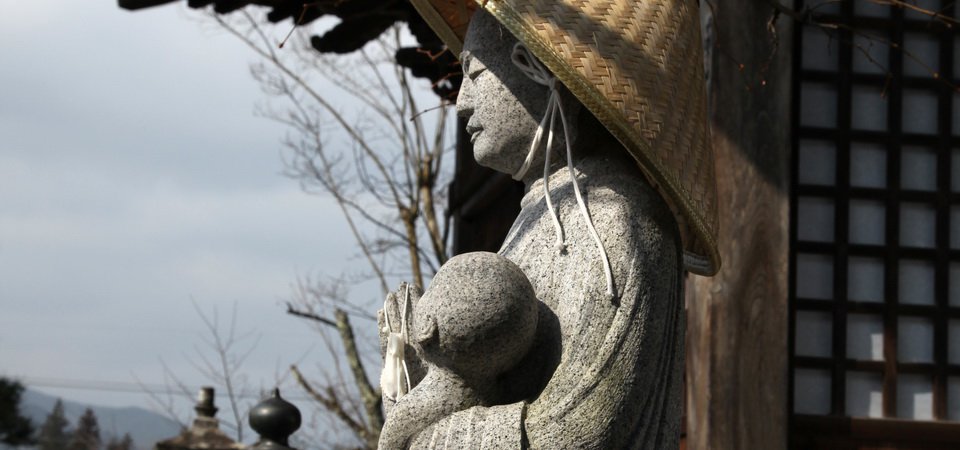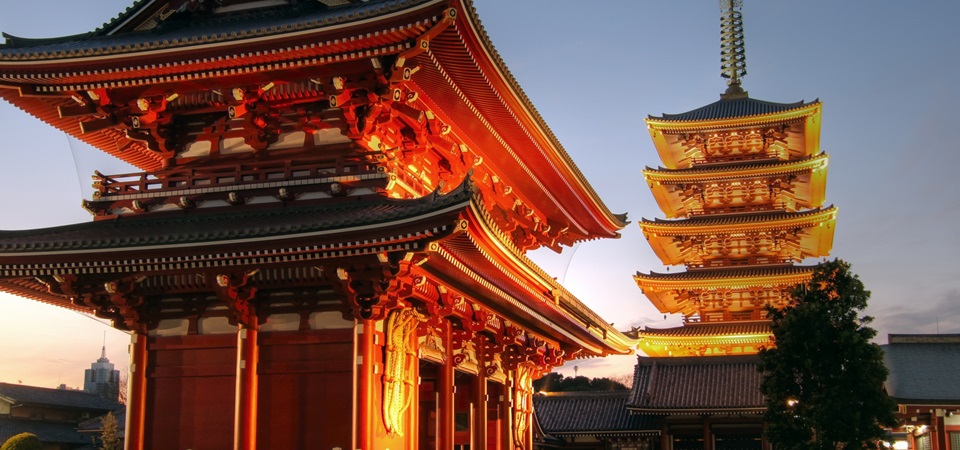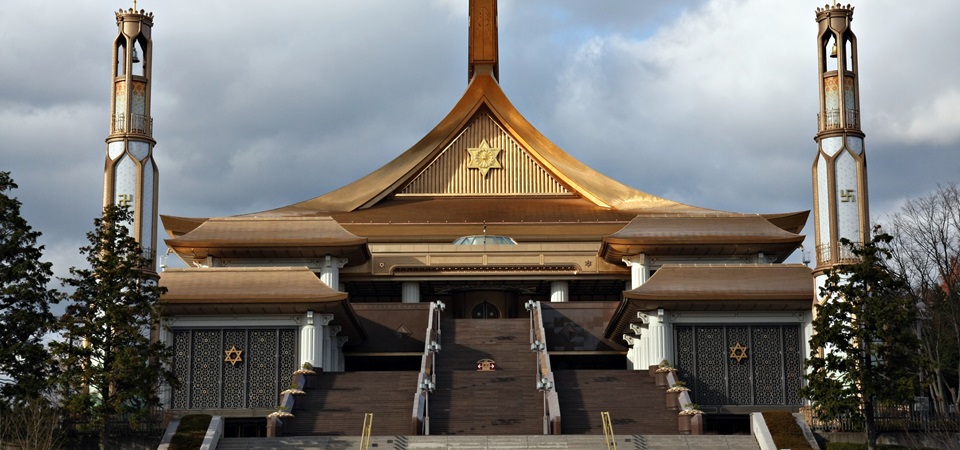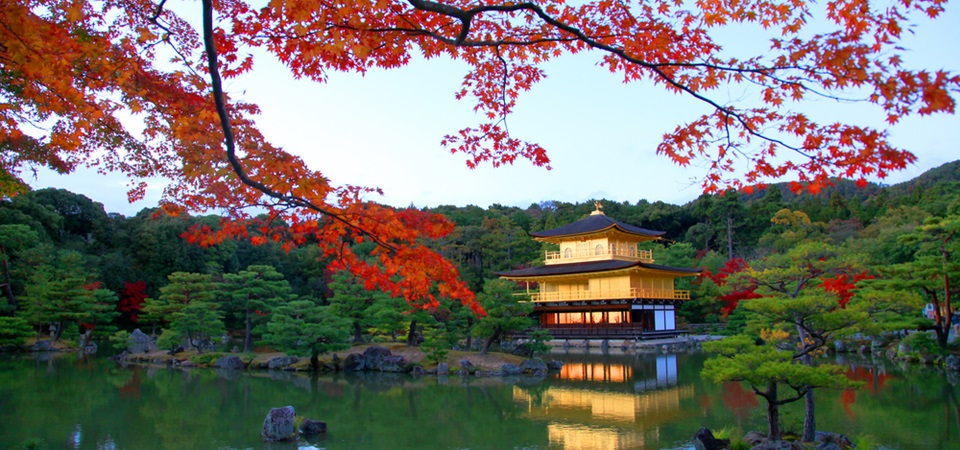Explore the vibrant cities, natural wonders and rich cultures that define Japan. Travel from the modern streets of Tokyo to bustling Osaka, stopping along the way for a dose of Buddhist insight in Koyasan, a trek through Japan’s scenic alps and to admire historic Kyoto and Nara.
Itinerary
📍 Narita International Airport (NRT) to Central Tokyo: 1.5 h Haneda International Airport (HND) to Central Tokyo: 50 min
Upon arrival to Tokyo’s airport, our representative will be waiting to assist with transportation into the city (either helping to board the right train or finding the appropriate shuttle van). After reaching the hotel and 00checking in, the remainder of the day is free at leisure.
Overnight in Tokyo
Inclusions:
📍 Time: Start (guided tour): 09:00 Duration: 8 h *including pick-up/drop-off and transit times
Meet up with the guide this morning in the hotel for the trip to Meiji Jingu, Tokyo’s most iconic Shinto shrine steeped in history and spirituality. Pass through the impressive torii gates leading to the shrine's inner forest of over 100,000 trees. Whether witnessing a traditional Shinto wedding procession or strolling through the lush grounds, Meiji Jingu provides an unforgettable experience of nature in the centre of Tokyo’s urban landscape.
Move on to the nearby districts of Harajuku and Omotesando, vibrant neighbourhoods that offer a unique and eclectic experience. Harajuku, renowned for its quirky street fashion, showcases an array of avant-garde boutiques and shops that cater to various subcultures. Omotesando, often dubbed Tokyo's "Champs-Élysées" presents a sharp contrast with its upscale, sophisticated atmosphere.
After lunch, use public transport to reach the beautiful Koishikawa Korakuen Garden, a traditional landscape that serves as an excellent example of Japanese garden design.
The final destination of the day is Asakusa. This charming district exudes a nostalgic charm and showcases
Tokyo's traditional side. At the heart of Asakusa stands the iconic Senso-ji, Japan's oldest Buddhist temple, drawing hordes of locals and tourists alike seeking blessings and cultural insight. The vibrant Nakamise Street leading to the temple offers a bustling market with a myriad of stalls selling traditional snacks, souvenirs, and handicrafts.
After a full day of touring the city, return to the hotel with the guide or part ways and continue exploring the city independently.
Note: The order of this itinerary may change depending on the location of your hotel
Overnight in Tokyo
Inclusions:
☕ Breakfast
Today is a self-guided day.
Suggested Self-Guided Itinerary:
Enjoy the rest of the day exploring this amazing city. Make an early start to visit the electronics district of Akihabara or discover Tokyo’s world-class museums and art galleries.
Alternatively, take an excursion in Kamakura. One of Japan’s former capitals, Kamakura is a delightful seaside town home to many ancient shrines, temples, and other structures like the Daibutsu, a giant bronze Buddha that stands at 13-meter tall.
Distance and journey time (approximation):
Tokyo Station to Kamakura Station: 50 min
Optional Tour (1): Cool Tokyo Cycling Tour
Today’s tour starts at 09:00 or 14:00. Meet the guide, who is sometimes ac companied by his adorable dog “Jack-san,” at Sasazuka Station, and head together to the cycling studio for a bicycle and helmet fitting. On the way, listen to some fascinating insights and entertaining anecdotes about the local neighbourhood, and get some useful explanations from the guide about Tokyo’s cycling etiquette and today’s itinerary.
When everything is ready, depart for today’s cycling tour. Leave Sasazuka with the guide, and cycle to the first location, enjoying the best of Tokyo’s urban design and natural environment on the way. Depending on the season, enjoy the surrounding foliage, which is especially beautiful in the spring when the plum and cherry blossoms bloom, and in the autumn, when the trees are a blaze of colour. There will be several cultural and architectural design stops along the way, where the guide will share interesting information and allow some time for photos.
Bike through Tokyo’s backstreets, local shotengai (small commercial streets) in hip neighbourhoods such as Shimo-Kitazawa, and some little-known parks, seeing the guide’s favourite areas and shops, and stopping for a break at a charming café.
Finally, enjoy the ride back to Sasazuka where the bicycles will be returned to the guide.
Time
Start: 09:00 or 14:00.
Duration: 3 h to 4 h
Journey: 10 km (mostly cycling, a bit of walking and light sightseeing also involved).
Optional Tour (2): Tokyo Street Food Tour
Upon arrival to Tokyo’s airport, one of our representatives will be waiting to accompany to the hotel by train or shuttle bus. The rest of the day is at leisure, until the scheduled food tour in the evening.
This evening tour will begin at 17:00. Be sure to bring an appetite: This is one Tokyo street food tour that is sure to please the taste buds! Meet with a local, food-loving guide at the train station and set off into the streets for a Japan-style food crawl.
Veer off into the maze of laneways that fill the capital, passing street carts selling exotic snacks and diners perched on small metal stools. Stop to sample some of the items on offer, from barbequed meats to sweet desserts. Then enter an izakaya for a distinctly Japanese experience. These small, Japanese-style pubs are popular gathering places for friends and colleagues to gather after work for a beer. The food on offer is meant to be shared and is thus served almost like tapas. The guide will order up a few traditional izakaya favourites such as fried chicken wings or cold edamame. Sample the dishes and wash them down with a cold, local beer alongside the locals.
While dining, learn more about Japan’s culinary culture by observing the lively surroundings and hearing the guide’s personal stories. During the evening, stop at four or five venues, each with a distinctive style. These venues do not take reservations so the exact routing may change but the guide will ensure there is plenty to eat!
Following an evening of culinary and cultural indulgence, return to the hotel for a good night’s sleep. (D)
Time (Street Food Tour):
Start: 17:00
Duration: approx. 3 h
Overnight in Tokyo
Inclusions:
☕ Breakfast
📍 Tokyo Station to Matsumoto Station: 3 h
Today is a self-guided day.
Travel to Matsumoto, a small castle town surrounded by rice fields, vineyards, wasabi farms and the great Japanese Alps.
Suggested Self-Guided Itinerary:
Spend the afternoon strolling around the city.
Visit Matsumoto Castle, one of the only twelve remaining original castles in Japan. It is well-distinguished for its black exterior, red arch bridge and views of the Japanese Alps in the background.
Right outside the castle grounds is Nakamachi-dori, a historical merchant district lined with well-preserved old buildings, including some storehouses characterized by their thick, white-painted walls.
Overnight in Matsumoto
Inclusions:
☕ Breakfast
📍 Matsumoto Station to Shin-Shimashima Station: 30 min Shin-Shimashima Station to Taisho-ike Bus Stop: 1 h
Today is a self-guided day.
Make an early start and travel to Kamikochi, a popular nature trail in the valleys of Matsumoto. It is known for the pristine Azusa-gawa River and the surrounding Japan Alps.
Start from Taisho-ike Pond, with its mirror-like waters reflecting the Hotaka Mountain Range and Mt. Yakedake, an active volcano that stands at 2,455 meters above sea level. Continue walking towards the bus terminal, passing by Tashiro Marsh, to secure a seat on the departing bus. Restrooms and food stalls are available for a quick break.
Just nearby is Kappabashi Bridge, one of the places in Kamikochi that offers the most picturesque views of the area.
From this point, another hour of trekking leads to Myojin-bashi Bridge, the gateway to Hotaka-jinja Shrine and Myojin-ike Pond. There is a small dining place here called Kamonjigoya that serves grilled freshwater fish and soba.
The trail from the Myojin area back to the opposite side of Kappa-bashi is another hour of nature trekking that runs through the serene woods of this well-protected national park.
Notes:
This is an easy-to-moderate course that can be accomplished in around 4 hours, including short restroom and meal breaks.
Kamikochi is only open from mid-April to mid-November, when the roads are not closed due to heavy snow.
Overnight in Matsumoto
Inclusions:
☕ Breakfast
Today is a self-guided day.
Start the journey through Nakasendo in Kiso Valley, one of the “Five Routes” that branched off the capital Edo and was controlled by the Tokugawa Shogunate from the 8th century.
Upon arriving in Magome, small carry-on bags can be delivered to any accommodation in Tsumago through the tourist information centre (08:30-11:30, from 21st March to 30th November).
The trail that runs from Magome to Tsumago is the most popular section of Nakasendo. Exit Nakatsugawa Station and catch the local bus to Magome, one of the post towns that flourished in the Edo Period. From Magome Bus Stop to Tsumago, the ancient trail can be completed in about 3 hours, including some quick breaks (i.e. restroom, tea/coffee).
Around 2 hours in, emerge to the well-preserved post town of Tsumago. Just like Magome, Tsumago was in its Golden Era during the time when merchants and other noble and prominent people frequently passed through for trade and other formal appointments.
In the latter part of 1970, this small town was classified as a National Designated Architectural Preservation Site, thanks to the collective effort of its locals to preserve most of the remaining historical buildings.
Overnight in Kiso-Fukushima
Optional Service: There is an optional private transfer from the end of the trail to the ryokan (extra charge).
Distance and journey time (approximation):
Matsumoto Station to Nakatsugawa Station: 75 min
Nakatsugawa Station to Magome Bus Stop: 30 min
Tsumago Bus Stop to Nagiso Bus Stop: 10 min
Nagiso Station to Kiso-Fukushima Station: 25 min
Trekking information (approximation):
Magome-juku to Magome-toge Pass: 2.2 km; 60 min
Magome-toge Pass to Otaki & Metaki Falls: 2.5 km; 50 min
Metaki Falls to Tsumago-juku: 3.3 km; 60 min
Elevation change (approximation):
Magome-juku (beginning of the trail): at 620 m
Magome-toge Pass: at 801 m
Tsumago-juku (latter part of the trail): at 430 m
Inclusions:
☕ Breakfast, 🍗 Dinner
📍 Kiso-Fukushima Station to Takayama Station: 4 h
Today is a self-guided day.
After an early breakfast, head out to Takayama, a small town nestled high in the Hida Alpine region of Gifu Prefecture. One of the trips is via the limited express train Wide View, which offers one of the most scenic train journeys in Japan.
Suggested Self-Guided Itinerary:
We recommend strolling in Takayama’s shitamachi, where the streets are lined with century-old merchants’ homes and sake breweries. Stop by one of the breweries for a taste of the local drop or queue for the famous Hida beef sushi in one of the special food stalls.
While in Takayama, experience a stay in a ryokan, the traditional Japanese-style inn furnished with low tables and chairs, sliding shoji doors, and tatami flooring.
Overnight in Takayama
Inclusions:
☕ Breakfast, 🍗 Dinner
📍 Takayama Bus Terminal to Shirakawago Bus Stop: 50 min
Optional Tour (1): Food & Culture Walk
Explore some of the food shops in Takayama with a knowledgeable guide, learning about the town’s colourful history and familiarizing the taste buds with some of the local delicacies. The walking tour includes visits to a tofu seller, a rakugan shop (traditional Japanese candies), and even a sake brewery (some stores may be closed during certain days). Food and sake tastings are also included.
Time:
Start: 09:30
Duration: 2.5 h
Optional Tour (2): Walking Tour in Hida Furukawa
Spend two and a half hours with the guide strolling around Hida-Furukawa, regarded as the twin town of Takayama. The guide will explain the history and culture of the town and the lifestyle of the locals.
Today’s tour teaches not only about the humble town, but also about how Hida-Furukawa and its people maintain a culture which can be traced all the way back to the Muromachi era (1337-1573).
Time:
Start: 14:00
Duration: 2.5 h
Distance and journey time (approximation):
Takayama Station to Hida-Furukawa Station: 15 min
In the afternoon, travel by bus to Shirakawago, a UNESCO World Heritage Site famous for its gassho-zukuri farmhouses.
Gassho-zukuri means "constructed like hands in prayer," which is represented through the farmhouses' steep thatched roofs. This architectural style developed over many generations – the roofs were constructed without any nails and are intricately designed to withstand large amounts of snow.
Despite being private homes, some of these houses are open to the public. One of these is the Wada House, a legacy left behind by the Wada Family who used to be the richest family and village leader in Ogimachi.
Note: Dinner will not be included this evening if staying at the Ryokan Asunaro.
Overnight in Takayama
Inclusions:
☕ Breakfast, 🍗 Dinner
📍 Takayama Station to Kyoto Station: 3 h
Today is a self-guided day.
Take one last soak in the onsen before starting the journey to Japan’s cultural capital, Kyoto. Kyoto is home to around 2,000 shrines and temples, including 17 UNESCO World Heritage Sites.
The rest of the day is at leisure.
Overnight in Kyoto
Inclusions:
☕ Breakfast
📍 Time: Start (guided tour): 09:00 Duration: 8 h *including pick-up/drop-off and transit times
Today’s tour starts with a visit to one of Kyoto’s most iconic sites: the Fushimi Inari Shinto Shrine. A lavishly decorated building houses the goddess of rice, and thousands of orange torii gates stretch up the mountainside in long tunnels. Unlike any other shrine in Japan, this is an ideal spot to understand how Shintoism is tied to respect for nature.
Board a train to Sanjusangendo, a stunning Buddhist temple often overlooked by tourists. A mesmerizing display of 1001 life-sized golden Buddhist statues awaits inside the world’s longest wooden building, sure to be one of the most memorable sights of the entire trip.
Take a taxi to the entrance of Nishiki Market, a long covered street of shops and stalls often called “Kyoto’s kitchen.” From traditional to sellers of tofu, fish, and pickles to shops showcasing knives and handicrafts, there is a tantalizing amount of things to see and taste here.
Don’t get too full snacking in the market, as lunch is next at a nearby restaurant. The guide will suggest locations based on the guests’ preferences (guests should notify guide of dietary restrictions at the start of the tour).
After lunch, travel to Nijo Castle, an ornamental palace built for the shogun in the early 1600s. The beautiful building is known for its finely painted walls and “chirping nightingale” floors that squeak under the feet of intruders. Walk the halls, see the audience chambers, and experience what it was like to visit the military ruler of Japan in the classic era of samurai.
Hop aboard the subway for a short ride to the eastern foothills of Kyoto. The final location of today is Nanzenji Zen Temple, a quiet retreat where monks have lived in peaceful repose since 1291. See the famous Zen rock garden whose meaning is left up to the viewer. Is it meant to be islands in a calm ocean, or a depiction of wild animals crossing a raging river?
After a full day of sightseeing, part ways with the guide and return to the hotel or continue to explore independently.
Overnight in Kyoto
Inclusions:
☕ Breakfast
📍 Kyoto Station to Nara Station: 45 min
Today is a self-guided day.
In the afternoon, head out of town and travel to Nara with the icluded Japan Rail Pass. For 74 years during the 8th century, Nara was Japan’s capital and many of the temples and shrines built at that time still remain.
Nara is just a small town, with most of its main tourist spots located around Nara Park, where large amounts of tame deer wander about freely. Visit Todai-ji Temple, the world’s largest wooden building housing Japan’s largest Buddha, and Kasuga Taisha, Nara’s most celebrated shrine.
Overnight in Kyoto
Inclusions:
☕ Breakfast
📍 Kyoto Station to Koyasan Station: 3 h Time: Start (guided tour): 9:30 Duration: 6 h *including pick-up/drop-off and transit times
Head to Osaka and meet the guide at Osaka Namba Station. Pass through river valleys and forested slopes as the train snakes its way into the mountains of Wakayama Prefecture, once thought to be home to ancient gods of nature. The final approach is made on Japan’s steepest cable car.
Welcome to Koyasan, a small community of over 100 temples of the secretive Shingon sect of esoteric Buddhism. This mountain enclave has endured for over 1,200 years, and remains a fascinating relic of a time when religion governed the politics and daily life of historic Japan.
Meet the guide at Koyasan Station and spend the afternoon exploring what Shingon followers believe is the center of the spiritual universe.
Visit Kongobuji, the head temple of Shingon Buddhism, home to Japan’s largest rock garden. Peek into beautifully decorated historic rooms and see the cavernous wooden kitchen where meals are still prepared for monks on special occasions.
Enter the brightly painted Konpon Daito Pagoda, which houses an awe-inspiring altar in the form of a three dimensional mandala that maps out the Buddhist cosmos with towering statues. This staggering sight is sure to evoke a sense of wonder in any onlooker.
Continue on to Okuno-in, Japan’s largest and most important cemetery. More than 200,000 gravestones are piled up in the shady spaces between soaring cypress trees, and the trail through this mossy landscape stretches for 2km. At the end lies the solemn Torodo Lantern Hall, where priests chant and eternal flames burn in memory of the deceased. Beyond is the final treasure of Koyasan: the mausoleum of Kobo Daishi, the founder of Shingon Buddhism and a pivotal figure in Japanese history.
After this remarkable journey through the spiritual past of Japan, guests are escorted to their shukubo (temple lodging) for the evening. A delicious shojin ryori vegetarian Buddhist dinner is served in a delightfully traditional atmosphere.
Overnight at Koyasan
Inclusions:
☕ Breakfast, 🍗 Dinner
📍 Koyasan Station to Nankai Namba Station: 2 h
Today is a self-guided day.
The rest of the day is at leisure until the scheduled departure from Koyasan.
Suggested Sightseeing Itinerary:
Join the optional morning prayer service at the temple lodging, which usually starts at 06:00, to hear the priests chant and drum as they greet the morning. Vegetarian breakfast is served after the service.
Explore the treasures of the Reihokan Museum, where thousands of religious items are on display. See vividly painted scrolls featuring intricate mandala diagrams of the gods and expertly carved wooden statues.
Walk to the west end of the town to see the official entrance to the town where pilgrims still arrive, the massive wooden Sanmon Gate that overlooks the river valley below. Nearby is the finely decorated golden Tokugawa Masoleum, the resting place of two early shogun of the Edo Period.
Board the cable car to descend to the station where an express train awaits for the return trip to Osaka.
Suggested Self-Guide Itinerary:
In Osaka, the following places are recommended:
Dotonbori
Dotonbori is a restaurant mecca which has long-been referred to as Osaka’s entertainment district. It is well-known for its bright neon lights, energetic shop owners and food stalls that are filled with some local Osakan delights such as takoyaki (octopus balls) and fugu (poisonous puffer fish).
Umeda
Umeda is where most of the city’s most modern buildings are found. Some of the notable buildings are HEP (Hankyu Entertainment Park), which features a big Ferris wheel and is perfect for some last-minute shopping; Kitashinchi District, housing some of the city’s culinary specialties; and the Umeda Sky Building, a pair of skyscrapers connected in “mid-air”, built in an unusual architectural form rarely seen anywhere in the world. Feel the fresh air and enjoy 360-degree panoramic views at the ‘Floating Garden Observatory’.
Optional Tour: Flavours of Osaka Food Tour
Today’s tour begins at 16:45. Osaka is an epicurean’s delight. Indeed, the motto that the city’s exuberant inhabitants live by is kuiadore– “to eat oneself bankrupt.”
The first stop will be at a street food stall to get a taste of some traditional Japanese snack food, menchi katsu. Menchi katsu is a breaded and deep-fried patty made of ground meat. Golden and crisp, this is a local favourite.
Next, head to a standing bar to enjoy the ambience and taste a selection of sake and Japanese wine, along with delicious house specialties. Then, head to a restaurant specialising in wagyu beef dishes. Often referred to as the most expensive beef in the world, wagyu beef is of a superb quality, and is on many a gourmet’s wish list. Enjoy the melt-in-the-mouth textures with a refreshing cocktail.
The final stop will be to try a new style of tempura in an eatery tucked away in a small alleyway. Old favourites such as shrimp tempura, and more experimental combinations such as asparagus tempura and cheese can be found on the menu.
Bid farewell to the affable guide, and either return to the hotel or go for a stroll around the neighbourhood to take in the sights.
Overnight in Osaka
Inclusions:
☕ Breakfast
📍 JR Namba Station to Kansai Airport: 50 min JR Shin-Osaka Station to Kansai Airport: 50 min
The rest of the day is at leisure until the departure flight from Kansai International Airport.
Inclusions:
☕ Breakfast
You might also like...
Here is a selection of products that may also fit the needs of your client.
Become a partner-
You might also like...
Here is a selection of products that may also fit the needs of your client.
Become a partner -
-
-
Get in touch
Our sales team is on hand to ensure that the process of working with us is as smooth as possible. If you should have any questions, feel free to reach out to them.

















